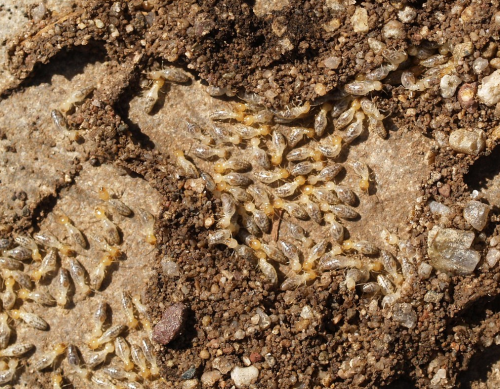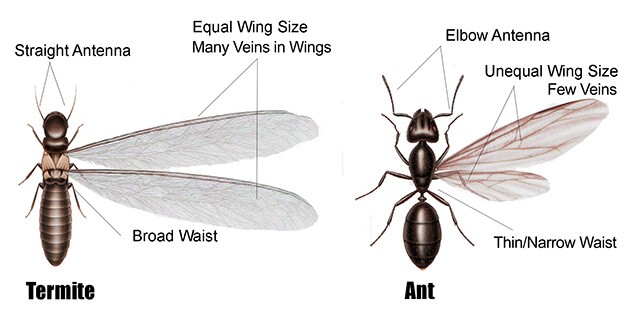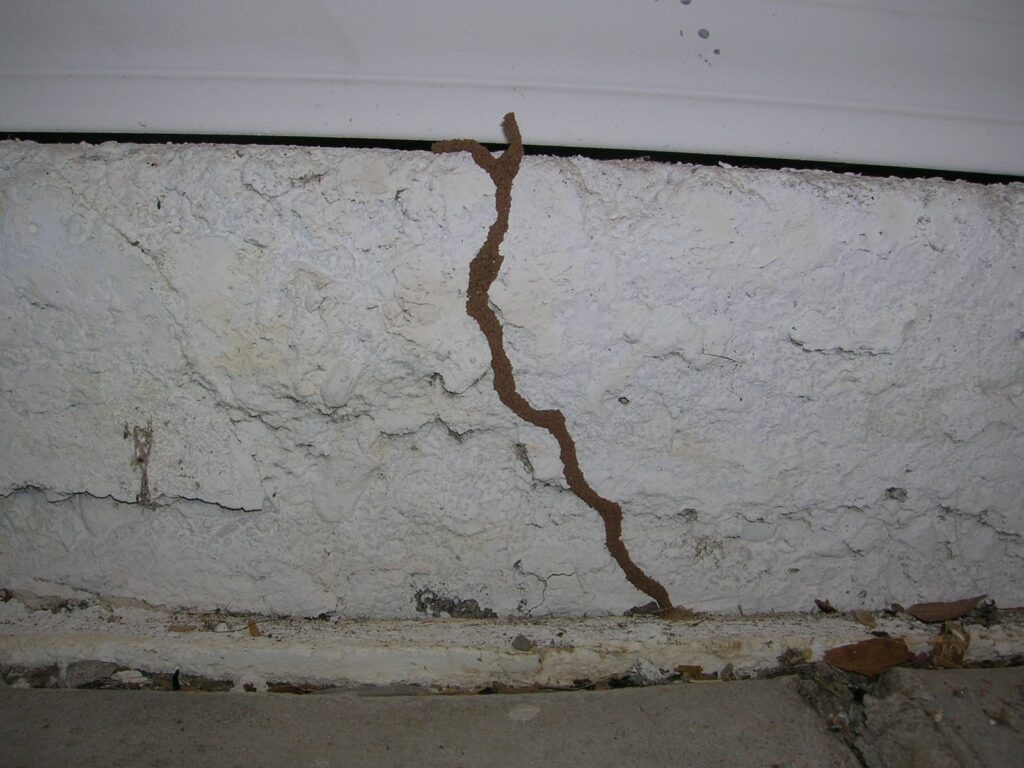Subterranean termites (Rhinotermitidae)
The most common type of termite found in North America is the Eastern subterranean termite (Reticulitermes flavipes).
As such this page will focus specifically on the Eastern subterranean termite’s characteristics and behaviors rather than subterranean termites in general. Being the most common type of termite in North America, they are found all over the United States reaching as far as Oregon.

How to identify subterranean termites
Smaller than the destructive Formosan subterranean termite, the Eastern subterranean alate (swarmer) measures around ⅜ inch. Due to its dark brown or black color, Eastern subterranean termite alates are often confused with carpenter ants. It is helpful to understand a few physical differences that distinguish one from the other:
- Waist: Subterranean termites appear to have a thick waist. Conversely, flying ants seem to have a thin waist. While both bodies have the same three parts (head, thorax, and abdomen), termites have a less distinct separation between the thorax and abdomen.
- Antennae: After examination, it is easy to recognize the difference in their antennae. Termites have straight or sometimes slightly curved antennae. Flying ants have bent or elbowed antennae.
- Wings: Other than their body shape, the wings are a good indicator of the type of insect. Eastern subterranean termites possess two pairs of brownish-gray wings that are equal in size. Flying ants will also have two pairs of wings, however, the front wings are longer than the back.
- Color: Both alate forms are dark in color. Eastern subterranean termites are either dark brown to black. Flying ants are typically black. The non-alate eastern subterranean, however, will be transparent to off-white.

Like other types of termites, Eastern subterranean termite colonies use a caste system in which each member has a role. Within the colony, each caste type has its specific role and specific features that help identify it. Eastern subterranean workers are small (around ⅛ inch) with soft, clear to creamy white bodies and a round head. They make up anywhere from 90-98% of colony members; workers may change castes depending on the colony needs. Although soldiers resemble workers, they are slightly bigger and possess a large, rectangular, yellowish-brown to orange head with long black mandibles. Soldiers are generally said to make up a small 1-2% of an eastern subterranean termite colony. And the alates, or winged termites, are larger in size, darker in color, and have two wings of the same size.
Where do subterranean termites live?
Eastern subterranean termites live throughout the eastern United States but exist as far as Oregon on the West coast. As they need moisture to survive, they build their nests in moist soil and are attracted to damp wood. Inside the home, Eastern subterranean termites will search for damp wood, generally targeting areas with high humidity levels. To survive, Subterranean termites depend on a reliable food source, water, and warmth. And while each type of termite has its wood preferences, no wood is entirely immune to an infestation. Subterranean termites, for example, typically prefer dead wood and other wood-like products containing cellulose.
Signs of infestation
Like many of the other wood-destroying organisms, subterranean termites can be difficult to spot with an untrained eye. Not only are they small and tend to stay hidden, but they do their damage from the inside out. Without knowing what to look for, these pests can go unnoticed and cause considerable damage to the home. Nevertheless, there are still some visible (and some not) signs to look for that could indicate a subterranean termite infestation. The ability to recognize the signs could be the difference between spending or saving thousands on home repairs.
The first sign usually appears during swarming season, when termite alates leave the nest to mate and expand the colony. It is possible to spot these flying termites inside the home or around the property. That depends on the location of the original nest. As these termites cannot fly very far, seeing them inside might indicate that the infestation is already underway. Usually, it is hard to see the termite itself, but it is possible to spot discarded wings near closed windows, doors, or on the floor. As the termites land to pair off and mate, they shed their wings which can then be found within the home. Swarming occurs when outdoor temperatures are warm so this period can change depending on the state and type of termite. The Eastern Subterranean termite, for example, swarms in Florida between November and April.

Additional signs within the home
Another more visible sign of subterranean termites is the apparition of mud tubes or galleries along basement or foundation walls. As subterranean termites require moisture and are vulnerable to dehydration, they build tunnels to travel from the colony nest underground to the food source above ground. Made from soil and wood and glued together with termite saliva, mud tubes protect and shelter the termites from dehydration and predators. The location of the mud tubes can also hint at the type of subterranean termite infesting the home. For example, tunnels that reach the ceilings or upper floors are specific to Formosan termites that do not need to hydrate as often.
Additionally, blisters in wood flooring, bubbling or cracked paint, or small holes in the drywall could also suggest a termite infestation. Since termites prefer the softer wood used in subflooring or support elements, an infestation could cause blisters on the hardwood floor. Bubbling or cracked paint can mean two different things: either termite damage or water damage, both of which can be serious issues. Bubbling paint caused by water damage due to a water leak could ultimately create the humid environment termites are looking for. If there is no water leak, check the wall behind the paint. If this area is soft, there could be termites present.